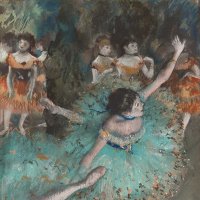Smoko. The Human Volcano
Reginald Marsh's Smoko, The Human Volcano depicts Coney Island, the popular-priced Brooklyn beach resort and amusement park that attracted New York's large urban populace during the Great Depression of the 1930s. Easily and inexpensively accessible by subway, Coney Island offered a welcome sea breeze to the masses confined in the city on a hot summer day. Marsh first went to the Brooklyn amusement park on assignment as an illustrator at the suggestion of Frank Crowninshield, the editor of Vanity Fair magazine.
Marsh loved the boisterous crowds and chaotic activity that he observed at Coney Island and so he began to make regular sketching trips there, finding constant inspiration for his paintings. He explained his response to Coney Island: "I've been going out there every summer, sometimes three or four days a week. On the first trip each summer I'm nauseated by the smell of stale food, but after that I get so I don't notice it. I like to go there because of the sea, the open air, and the crowds-crowds of people in all directions, in all positions, without clothing, moving-like the compositions of Michelangelo and Rubens." Around the time he painted this lively canvas, Marsh wrote to his wife Felicia, a landscape painter who spent her summers in Vermont, telling her of his most recent afternoon at the beach at Coney Island: "The wind was fresh and strong blowing great whitecaps in on the seas-the sea a rich blue-The crowd as thick as I've ever seen, much to my delight. The noise of the beach could be heard for miles and there was scarce room on the sand to sit down..."
Marsh made a sketch for Smoko, the Human Volcano on one of these jaunts to Coney Island. In the sketch, both the figure of Smoko and the woman wearing shorts standing just below are clearly visible. But Marsh also took photographs of his subject. He considered his photographs to be snapshots, a kind of visual note-taking, rather than as finished works of art. The photographs' subjects are in the documentary tradition of his contemporaries Berenice Abbott and Walker Evans, but his use of his own photography to create paintings can be compared to Ben Shahn and Ralston Crawford.
Four of the photographs Marsh used for Smoko, the Human Volcano show that he faithfully recorded the publicity logo from the billboard of the sideshow: "[fa]tilist supreme" and "Smoko the human volcano: startling feats of fire eating." To the left of Smoko's billboard image, Marsh depicted a poster of a female fortune teller or psychic who points to her crystal ball with phrases like "tomorrow" emanating from it. Beneath her the caption reads; "x-ray your mind." In the painting, Smoko, standing before his image on the billboard, is depicted performing his act, about to swallow fire. Wearing a wide print tie and orange suspenders, he dramatically throws his head back, about to insert the flaming torch. To the right of the female performer scantily clad with a bare midriff and shorts, Marsh painted another figure drawn from his photographs: a girl of short stature, wearing a headband in her hair, a bright red dress and lipstick. Marsh placed the spectator among the crowd, looking up at the performers.
Gail Levin







